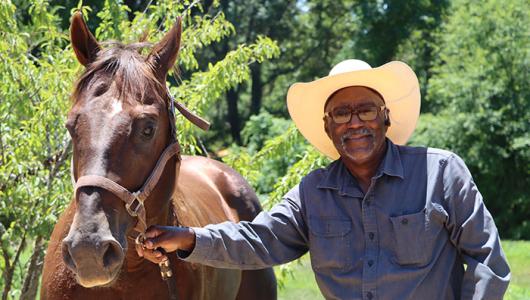In a corner of Salmon, Idaho, magic is happening. Bit by bit, Jessica McAleese and Jeremy Shreve are working together and with the land to transform former pastureland into a diverse and regenerative farm-scape. Where once there were just a handful of species of birds, now there are more than 100, residing, feeding, or nesting at, or migrating through Swift River Farm each year. A riot of different annual and perennial crops, trees, shrubs, and flowers now create a colorful palette contrasting the acres of grazed, hayed, and monochrome green pastureland just on the other side of the fence line.

Thanks to additional funding from the Inflation Reduction Act provided through USDA’s Conservation Stewardship Program (CSP), Jessica and Jeremy are getting help implementing several mitigation activities called enhancements. Through CSP, USDA’s Natural Resources Conservation Service (NRCS) helps producers enhance their existing conservation efforts, using new practices or enhancing existing practices, based on their management objectives. The CSP enhancements Jessica and Jeremy chose include conservation cover for pollinators and beneficial insects, establishment of Monarch butterfly habitat, planting tree and shrubs for wildlife food, intensive cover cropping to increase soil health and soil organic matter content, and mulching with natural materials in specialty crops for weed control.
Jessica and Jeremy selected these specific CSP enhancements to support their vision of being one of many diverse, small-scale farms and ranches playing the role of “connective tissue” – creating critical habitat between the forests and the farms/ranches within the larger landscape, while also enhancing soil carbon and sequestering carbon in perennial plants, shrubs, and trees. Many miles of neighboring large pastures and hay fields up and down the valley are largely devoid of pollinator habitat, which is part of the reason they chose a diverse cover crop mix including peas, oats, rye, vetch, phacelia, buckwheat, radish, turnip, mustard, and a wide mix of clovers. Their contract covers just over nine of their total 10.4 acres of land.
“There are so many Conservation Stewardship Program enhancements applicable to a farm of our size...It was hard to choose,” Jessica said. “We were already doing many of them and had plans to expand our efforts in the coming years.”

Jessica is appreciative of the support she’s received from NRCS, and she’s seeing the results.
“It’s nice to see things thriving,” Jessica said. “The milkweed is spreading seed. We put in hundreds of bare root shrubs and trees – almost all have survived. The elderberry is getting huge!”
Jessica and Jeremy are not only passionate about restoring the biodiversity of their corner of Idaho, they are also keen to share with others. Swift River Farm often hosts single-day workshops on seed starting, composting, pollinator habitat, and many other topics on their farm. They have served as mentors for small-scale producers, offering time and support as well as full season apprenticeships. In addition, for the last 16 years, they also ran a Community-Supported Agriculture (CSA) program, feeding 50-75 families in the region every year. Even though this season looks a bit different focusing on seed, the community connection remains a strong priority. They will sell this year’s diverse variety of seed crops to the Snake River Seed Cooperative, Fedco Seeds, and Siskiyou Seeds. All of which support the work of smaller farms like Swift River.

“Often these types of programs get funneled towards bigger producers, because they are already connected into agency resources,” said Jessica. “So, go! Don’t wait for an invitation. If you wait to be contacted, you are missing out.”
Mindi Rambo is a public affairs specialist for NRCS in Idaho.


